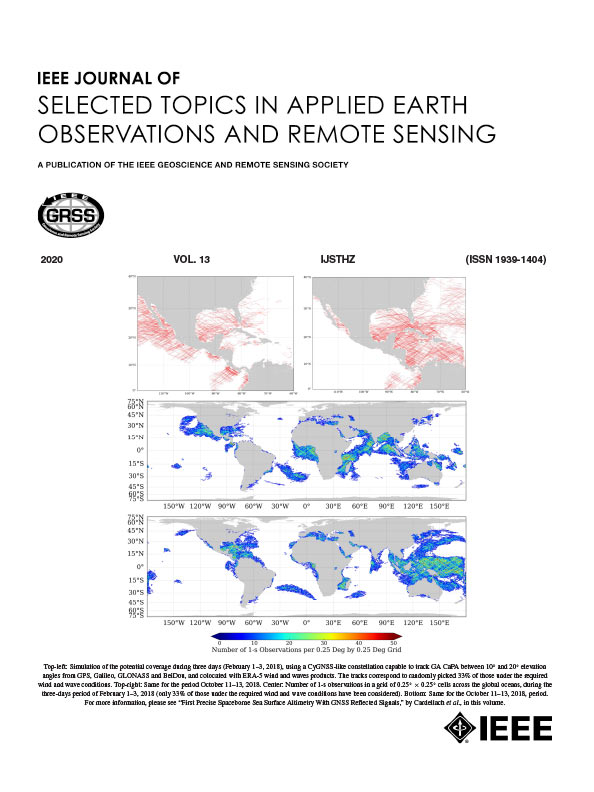基于结构先验信息的条件对抗训练的闭塞感知窗口分割
IF 4.7
2区 地球科学
Q1 ENGINEERING, ELECTRICAL & ELECTRONIC
IEEE Journal of Selected Topics in Applied Earth Observations and Remote Sensing
Pub Date : 2025-03-12
DOI:10.1109/JSTARS.2025.3550632
引用次数: 0
摘要
窗口分割和矢量化仍然是一个重大挑战,特别是在没有干净的立面图像的情况下。为了从有遮挡的建筑斜面图像中提取完整的窗口段,本文提出了一种基于先验结构信息的条件对抗训练的遮挡感知窗口分割(OA-WinSeg)网络。这种架构结合了图像分割和生成能力来处理遮挡。首先,OA-WinSeg自动检测遮挡并从粗糙的窗口分割中生成矩形边界引导,并将建筑布局的结构信息融入到该过程中。随后,该网络通过关注图像中未遮挡部分的上下文信息,对粗分割进行细化,并在缺失区域生成窗口段。最后,我们的方法生成准确的向量表示,这是建筑建模系统所需的信息。实验结果证明了该模型在模拟和遮挡的真实世界数据集上的有效性。此外,我们在各种烧蚀研究中评估了我们的模型,以探索不同模块的贡献。最后,我们分析了所提出的分割网络和已完成的窗段的潜在应用,包括建筑立面的油漆。本文章由计算机程序翻译,如有差异,请以英文原文为准。
OA-WinSeg: Occlusion-Aware Window Segmentation With Conditional Adversarial Training Guided by Structural Prior Information
Window segmentation and vectorization remains a significant challenge, particularly in the absence of clean facade images. To extract complete window segments from building façade images with occlusions, this article proposes an occlusion-aware window segmentation (OA-WinSeg) network with conditional adversarial training guided by prior structural information. This architecture combines the power of image segmentation and generative capabilities to handle occlusions. First, OA-WinSeg automatically detects occlusions and generates a rectangular boundary guidance from a coarse window segmentation, which incorporates structural information about the building layout into the process. Subsequently, the network refines the coarse segmentation and generates window segments in the missing regions by attending to contextual information of the nonoccluded parts of the façade. Finally, our approach generates accurate vector representations, information needed for building modeling systems. Experimental results demonstrate the effectiveness of our model with simulated and occluded real-world datasets. In addition, we evaluate our model on various ablation studies to explore the contribution of the different modules. Finally, we have analyzed the potential applications of the proposed segmentation network and the completed window segments, including building façade inpainting.
求助全文
通过发布文献求助,成功后即可免费获取论文全文。
去求助
来源期刊
CiteScore
9.30
自引率
10.90%
发文量
563
审稿时长
4.7 months
期刊介绍:
The IEEE Journal of Selected Topics in Applied Earth Observations and Remote Sensing addresses the growing field of applications in Earth observations and remote sensing, and also provides a venue for the rapidly expanding special issues that are being sponsored by the IEEE Geosciences and Remote Sensing Society. The journal draws upon the experience of the highly successful “IEEE Transactions on Geoscience and Remote Sensing” and provide a complementary medium for the wide range of topics in applied earth observations. The ‘Applications’ areas encompasses the societal benefit areas of the Global Earth Observations Systems of Systems (GEOSS) program. Through deliberations over two years, ministers from 50 countries agreed to identify nine areas where Earth observation could positively impact the quality of life and health of their respective countries. Some of these are areas not traditionally addressed in the IEEE context. These include biodiversity, health and climate. Yet it is the skill sets of IEEE members, in areas such as observations, communications, computers, signal processing, standards and ocean engineering, that form the technical underpinnings of GEOSS. Thus, the Journal attracts a broad range of interests that serves both present members in new ways and expands the IEEE visibility into new areas.

 求助内容:
求助内容: 应助结果提醒方式:
应助结果提醒方式:


